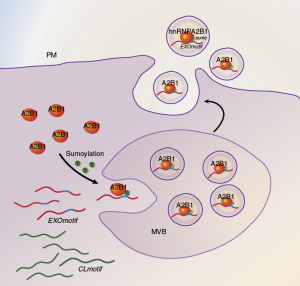Extracellular vesicles, such as exosomes and microvesicles, have recently been discovered to contain different types of regulatory RNA such as long non-coding RNA (lncRNA). The lncRNA are a group of diverse non-coding genes that are being increasingly implicated in biological processes, but they remain poorly characterized and understood. Their role in cancers such as hepatocellular cancer (HCC) has been increasingly recognized. We have discovered that some lncRNA that contain highly conserved sequences, termed ultraconserved RNA (ucRNA), are transcribed and altered in HCC. We examined the role of extracellular vesicles in mediating intercellular transfer of these lncRNA and influencing tumor cell behavior. We found that lncRNA could be isolated in extracellular vesicles secreted from cultured HCC cells and then internalized by other cell types. By profiling RNA expression in these extracellular vesicles and their donor cells, we identified and then cloned a ucRNA highly expressed and enriched in extracellular vesicles. This novel lncRNA, termed TUC339, was found to modulate tumor cell growth and adhesion. Suppression of TUC339 with siRNA reduced HCC cell proliferation, clonogenic growth and anchorage independent growth. Inversely, enforced expression of TUC339 increased cell proliferation, thus representing a functional mechanism by which intercellular transfer of TUC339 can promote HCC growth and spread. We conclude that these findings support the existence of selective mechanisms for lncRNA export from cells and implicate the transfer of lncRNA via extracellular vesicles as a mechanism by which tumor cells can modulate their local cellular environment.
https://www.ncbi.nlm.nih.gov/pmc/articles/PMC3807642/
Kogure T, Yan IK, Lin WL, Patel T. (2013) Extracellular Vesicle-Mediated Transfer of a Novel Long Noncoding RNA TUC339: A Mechanism of Intercellular Signaling in Human Hepatocellular Cancer. Genes Cancer 4(7-8), 261-72.


